Saving in the cloud. How to optimize your daily infrastructure expenses?
-
 Mateusz Bohonos, Product Manager One Step Cloud
Mateusz Bohonos, Product Manager One Step Cloud

This question is asked by most owners, directors responsible for IT maintenance in the company. In the article below, I will lean on the real numbers and calculate how much we are actually able to save thanks to the cloud. I will also show how to do it to get the best result.
In the era of increasingly popular remote work, we face a lot of offers from various cloud providers. We already know the pros of a cloud such as:
- we don’t have to take care of the equipment warranty
- we don’t have to worry about the administrator’s unavailability/sickness
- we don’t have to worry about physical defects
- we don’t have to worry about cooling and protecting servers
- we don’t have to worry about security and hacker attacks (if we don’t cause the threat by sharing our password ourselves)
- we don’t have to buy all my equipment right away
- we can “click” to create/change the resources of our machines, or applications
The question is:
Are we really aware of all these advantages?
Are we valuing all the components ourselves in a good way?
We often make mistakes when valuing the profitability of the cloud, which may have an impact on the decision on the profitability of IT migration and you will read about one of them below.
Valuation of my infrastructure in the cloud
Facing with a choice “on-premise” or “online” in the sense of whether you have your own database server or the cloud, we have specific needs in our business and we value the components of our server. We will analyze two examples:
- Running an office with 10 employees who need remote working
- Running an analytical company with 5 employees performing calculations and analyses for other companies
Let’s make some organizational, human, and equipment assumptions. What kind of hardware we need to buy for a period of about 3 years (that’s what the server warranty usually takes). What kind of employment we will have during this time.
Ad 1. Office work:
- Number of employees: currently 10, target 20
- Working hours: Mon-Fri 8-16
- Operating System: Windows Server 2019
- The amount of space needed for each user: 20 GB SSD 100 GB HDD
- Number of vCPU: currently 6 targets 12
- Number of RAM: currently 32 and 64 GB target
Ad 2. Analytical work:
- Number of employees: currently 5 targets 10
- Working hours: Mon-Fri 8-16
- Operating system: Ubuntu 20
- The amount of space needed for each user: 10 GB SSD
- The total amount of analytical data: 200 GB SSD target 500 GB
- Number of vCPU: currently 8 targets 16
- Number of RAM: currently 32 GB, target 64 GB
The first mistake we usually make is to transfer 1 to 1 hardware requirements that we need for 3 years. Currently, our equipment usage is on average 20-50% lower than we assume in 3 years.
One of the advantages of the cloud is the ability to quickly create and modify infrastructure. When planning our resources in the cloud, we should allow for this and value the current consumption in a way that does not overpay. I will write about comparing the costs of a cloud with a server in another article.
Let’s consider an offer to create entire virtual machines (IaaS) in the infrastructure of the Polish company Intratel, which is available through the One Step Cloud portal. Focusing on the valuation of current conditions and hardware needs we can price our equipment as follows:
Option 1: When we estimate the cost of the cloud with the cost of the target infrastructure (in 3 years time), we have such values:
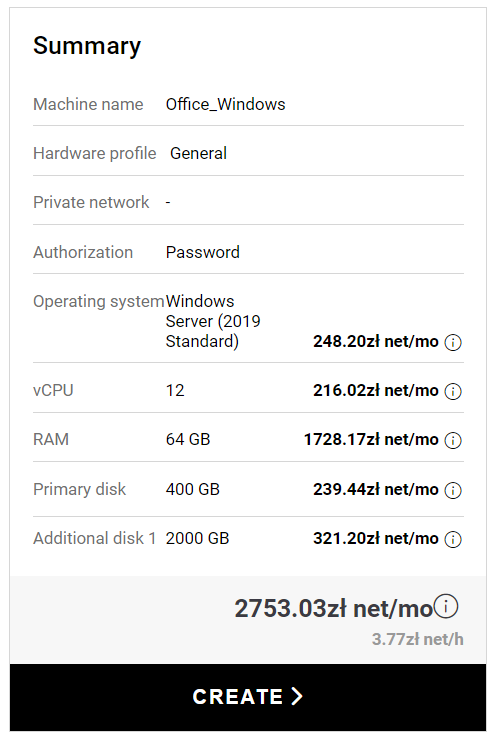
However, actually our valuation should be as follows (current state):

The difference in valuation is as follows: 2753,03 – 1500,62 PLN = 1252,41 PLN
Option 2: Creating a machine in the cloud with the target infrastructure would cost us:
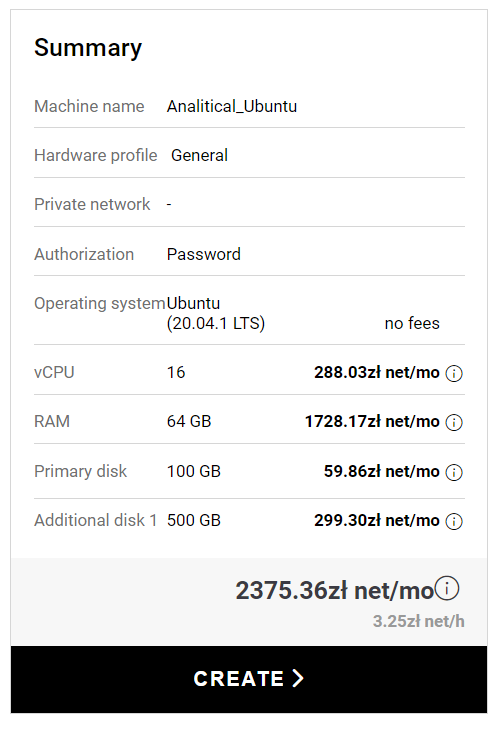
However, we should actually compare the valuation below:
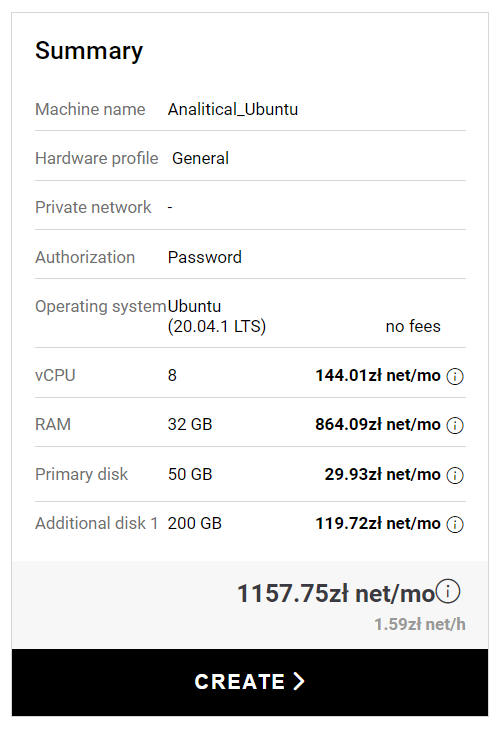
The difference in valuation is as follows: 2375,36 – 1157,75 PLN = 1217,61 PLN
As we notice, our valuations can be wrong, so it is always worthwhile to ask an expert, a person from the company, for a valuation of our infrastructure, so as not to be alienated by unnecessarily bad assumptions.
Below I will present how to effectively use the advantages of the cloud. Based on the One Step Cloud portal, the user can turn on and off virtual machines at any time. What do we need it for? To save money!
Intratel as the owner of the portal, gives us the possibility of billing per second.
The pay-as-you-go system refers at this point in time to charging for using vCPU and RAM only as many seconds as we have enabled our virtual machines. Other components such as the operating system license or disk space are also charged per second, but are counted for the entire lifetime of the machine. No fees are charged when you turn off the virtual machine. The second billing is important because it does not charge for a full hour when you turn off the machine at 16:03 for example.
Moving on to the details, let’s take a look at the hourly settlement of our machine.
Option 1: Virtual Windows machine:
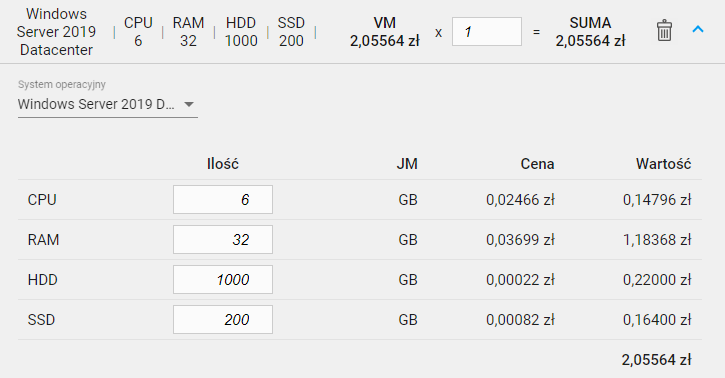
Option 2: Ubuntu Virtual Machine:
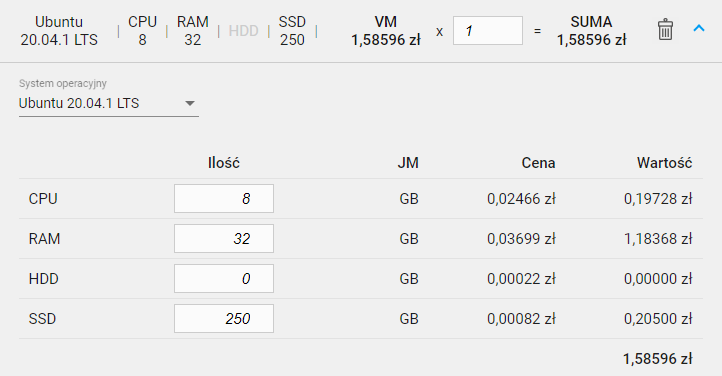
Assuming that our employees work from Monday to Friday between 8 a.m. and 4 p.m., we can assume an average of 160 hours a month, where a month is 730 hours. The cost for our virtual machine in the hours when employees do not work and we will turn it off will be as follows:
Option 1: Virtual Windows machine:
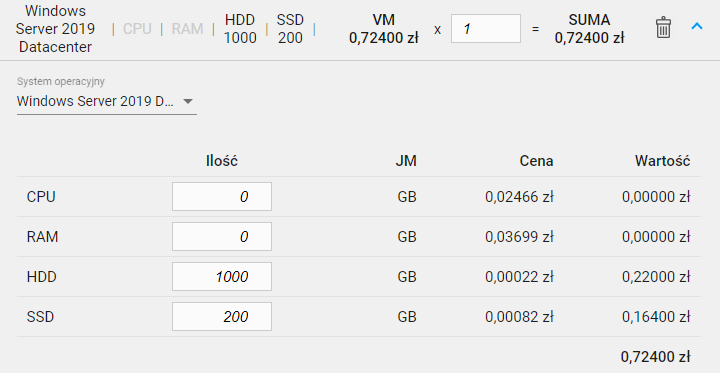
Option 2: Ubuntu Virtual Machine:
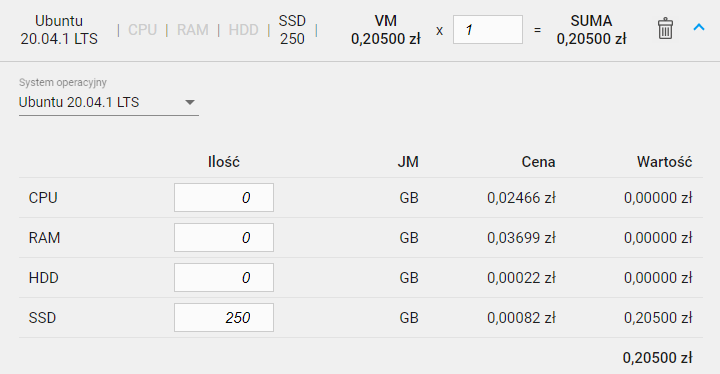
Let us therefore count the use of our machine for 160 hours as fully loaded and 580 (730-160) hours as off.
Option 1: Virtual Windows machine:
(2.05564*160) + (0.72400*580) = 748.82 PLN per month instead of 1500.62 PLN
Turning off the machines allows us
save more than 50 % of costs.
Option 2: Ubuntu Virtual Machine:
(1.58596*160) + (0.20500*580) = 372.65 PLN per month instead of 1157.75 PLN
Turning off the machines allows us
save over 67 % of costs.
Let’s note that the actual cost we will incur is totally different from the assumed cost of the infrastructure, which is supposed to last us 3 years. With business models, where machines mainly use calculations, it is even advisable to use the cloud to reduce costs.
I’ll add that One Step Cloud exposes a public API, so we can write a script that will shut down our machines at appropriate times. You can also write a script to optimize the usage of individual machines depending on their load at the moment.
The above mentioned solutions are already being used by our customers and they do not think about changing their business model now. It is both convenient, safe and profitable for them. Therefore, try to set up a free account and collect 100 PLN to check out our infrastructure.
Author: Mateusz Bohonos, Product Manager One Step Cloud




